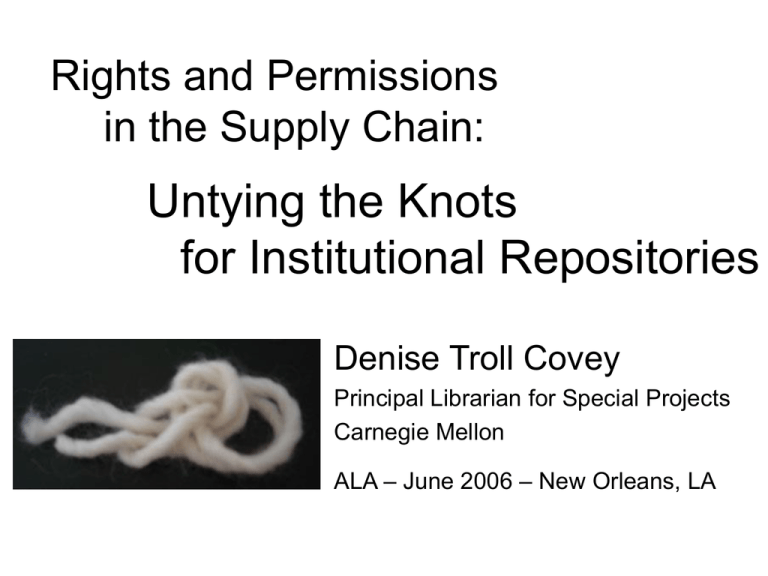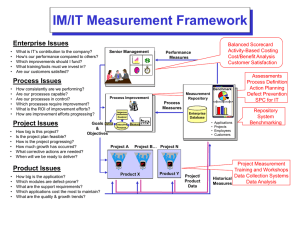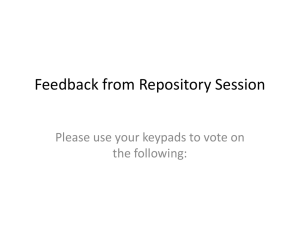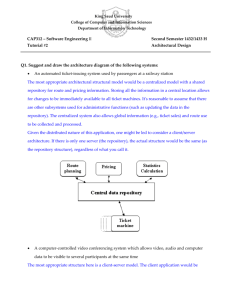Untying the Knots for Institutional Repositories Rights and Permissions in the Supply Chain:
advertisement

Rights and Permissions in the Supply Chain: Untying the Knots for Institutional Repositories Denise Troll Covey Principal Librarian for Special Projects Carnegie Mellon ALA – June 2006 – New Orleans, LA Rights & permissions • Rights are granted by law – Copyright is right to reproduce, distribute, perform & display publicly, & make derivatives • Exceptions & limitations for libraries • Fair use / dealing exception for the public • Permissions are granted by rights holders – Permissions specify rights, e.g., display, print, save – Restrictions & conditions may apply, e.g., use with attribution, use by certain groups, use for certain purposes, use for a limited period of time Roles in the supply chain • Rights holders • Rights mediators • Users • Rights creators & enforcers • Rights definers & interpreters Stakeholders can play multiple roles Roles are changing NISO workshop May 2005 – Denver, CO Rights holders • Own the rights or are empowered to grant rights to others • Have different philosophies, motivations, concerns, & priorities Faculty Student Institution 3rd Party Rights mediators Course management • Convey rights in compliance system Library with the law Portal & license terms set by rights holders Other In the United States, Collaborative environment the library is responsible for 80% of IR operations (2005 CNI survey) Repository operators Other mediators Users • Exercise rights granted (or not) to them WORLD • Attempt (or not) to interpret rights REGION INSTITUTION DEPARTMENT CLASS SELECTED OTHERS The repository supply chain Faculty Student WORLD Institution REGION INSTITUTION 3rd Party DEPARTMENT CLASS SELECTED OTHERS Library Other mediators Other The regulatory environment • Rights creators & enforcers – Create rights & compel obedience • Rights definers & interpreters – Explain the meaning & significance of rights • Laws – Copyright – Licenses • Policies – Intellectual property – Authentication – Access control – Privacy & confidentiality – Self–archiving Libraries must uphold …. • The law – Secure right to copy, distribute & preserve content • Deposit license between © holder & institution – Protect distribution & use of content • Distribution license between © holder & user • Institutional policies • Professional ethics Library Knots • Defining the repository • Concerns about copyright • Identifying solution requirements • Rhetoric of rights management Defining the repository • 1994: Self–archive published work (Stevan Harnad) – Maximize impact via free access • 2002: Re–shape scholarly publishing (Raym Crow) – Address affordability problem & regain control • 2003: Advance, support, & legitimize new forms of scholarly communication (Cliff Lynch) – Preserve & provide access to institution’s assets Continuum • What purpose(s) does the repository serve? • What content does it contain? An open–access collection of work published by faculty A digital library of the community’s cultural & intellectual life Rights get more complicated 2005 CNI survey of 97 U.S. institutions Repository content types & post-prints Pre– Pre-prints & post–prints Special collections Theses & dissertations Tech reports & working papers Images Conference presentations Conference proceedings Journals Audio Student papers Current Maps University publications Planned Video 0% 10% 20% 30% 40% 50% 2005 CNI survey of 97 U.S. institutions Repository content types Department materials & records Learning objects Course syllabi & lectures Data sets E-books Performances University records Musical scores Interview transcripts Software Plans & blueprints Current Exhibits Planned E-portfolios Newspapers 0% 10% 20% 30% 40% 50% Repository as digital library – Preserve & leverage assets • Increase impact (OA) • Showcase quality • Centralize & introduce efficiencies in stewardship • Encourage collaboration • Rescue – Facilitate change in scholarly publishing – Support faculty practices • Services RIGHTS • Rationale(s) – Capture – Organize – Manage – Steward – Disseminate – Preserve – Interoperate 2005 CNI, JISC & SURF surveys Volume of repository content Percent of universities with a repository Average number of documents 100% 3500 3000 75% 2500 2000 50% 1500 1000 25% 500 S 0 U Au st ra Be lia lg iu C m an D ada en m ar Fi k nl an Fr d an G er ce m an y Ita N ly or w Sw ay N et ed he en rl a nd s U K 0% Current status: little content • 2004: survey of 45 repositories – Average 1250 items; median 290 items • 2005: survey of 97 U.S. institutions – 25% archive (9% plan to archive) pre– & post–prints – No comparable data • 2006: 400 OA repositories – 50% average 40 items; 25% are empty – At least 50% of contents are NOT full text 93% of journals allow self–archiving Takes little time to self–archive Why so few contributions? • 2005: Rochester IMLS research – Mismatch of vocabulary, incentives, & workflows – Copyright concerns • 2006: UK rights & rewards study – – – – – Only 16% prefer institutional repository Awareness & workings of repository systems Lack of time, reward or incentive Institutional policies Attitudes of peers – Copyright concerns Copyright as barrier to contribution • Who owns the copyright? Teaching materials Research papers Academics own 13% 61% Institution owns 26% 7% Don’t know 55% 32% Rights & Rewards RoMEO in Blended IRs Studies 1 January 2006 2003 • What about archival & other materials? Faculty copyright concerns • Teaching materials – Will their work be safe & attributed to them? – Can they deposit work with 3rd party content? – Who & how will people be able to use their work? Rights & Rewards, January 2006 • Research materials – 32% concerned won’t get published if self–archive – 30% concerned self–archiving will break agreements – 10% ignore agreements & self–archive RoMEO Studies 1, 2003 Rights & Rewards Incentives Likely to contribute to repository Much more likely to contribute Support Management & preservation Necessary for pay award Most people in subject are contributing Compulsory in institution Leaders in subject are contributing Compulsory in department Necessary for promotion Assert copyright Assert copyright Other motivator: improvements in rights awareness 0% 25% 50% 75% 100% Copyright as barrier to use • Faculty are more likely to use than to contribute to a repository, but if they use repository content – 40% are unclear about their right to use or modify – 30% had difficulty locating copyright information Rights & Rewards, January 2006 58% self–archive research papers 88% use open–access research papers RoMEO Studies 2 & 3 Copyright as management issue • Hard copyright problems for repository managers – Authors are ignorant of copyright & wary of depositing – 3rd party content, learning objects, & images Linking UK Repositories, June 5, 2006 • Some faculty don’t … – – – – – Know if they own or transferred copyright Understand, read, keep or carefully file agreements Care what the agreements say Have the time or confidence to negotiate Understand the value of open access Preliminary results Carnegie Mellon study 2006 Rights management is the most significant repository policy issue & implementation challenge McCord, IR: Enhancing Teaching, Learning, & Research, EDUCAUSE, 2003 Identifying solution requirements • Rights to be managed – Rights holders requirements – Rights mediators requirements – User requirements • Other issues Library Rights & Rewards Access to teaching materials Faculty only 3% Authenticated access 29% Open access 27% Department only 4% Students only 6% Institution only 11% Different access for different materials 20% Mismatch with faculty preferences • Most repositories are open access – Only 27% would allow open access to their teaching materials WORLD • Some repositories have access control – Mapped to groups – 20% want different access for different teaching materials REGION INSTITUTION DEPARTMENT CLASS SELECTED OTHERS Faculty restrictions on use Teaching materials Research papers Display Display Play Play Print Print Save Save Excerpt Excerpt Give Give Free Restricted Not at all 0% 25% 50% 75% 100% 0% 25% 50% 75% 100% Faculty restrictions on use Teaching materials Le nd Lend Free Restricted C op y Copy gg nn re ot od ga at ify te e Aggregate A Annotate Modify M A Sell Se ll Not at all Research papers 0% 25% 50% 75% 100% 0% 25% 50% 75% 100% Other restrictions Use for certain purposes Exact replicas Use by certain groups Research Personal use only Teaching For a time period Geographical regions Limited number of times 0% 25% 50% 75% 100% Other conditions Author attribution Usage tracking Research Agree to terms & conditions Teaching Users must register No conditions 0% 25% 50% 75% 100 Rights holders requirements • Attribution • Ability to – Assign different rights to different users – Manage rights inherited from multiple sources as content is aggregated, repurposed, redistributed • Unique identifiers for content • Usage tracking & reporting • Security & interoperability • [Compensation] NISO workshop May 2005 – Denver, CO Rights mediators requirements • Same as rights holders PLUS • Branding • Legally defensible, [machine actionable], persistent, standardized rights expression • Ability to – Convey rights to users – [Control] who can do what, how, when, & where • Ambiguity to enable negotiation NISO workshop May 2005 – Denver, CO User requirements • Seamless access • Display of rights granted • Right to – Copy for personal use – Excerpt – Annotate for personal use With the exception of sharing & excerpting research material, < 50% of faculty would allow unrestricted copying, excerpting, annotating, aggregating or sharing – Aggregate & disaggregate – Share with colleagues – Apply accessibility technology NISO workshop May 2005 – Denver, CO Rights requirements for research AUTHORS require USERS require PERMISSIONS Sounds like Display Display Creative Give Give (optional) Commons Print Print Excerpt Excerpt Save Save Non–commercial Aggregate (opt) Aggregate (opt) No Derivatives RESTRICTIONS Exact replicas Attribution license Exact replicas For certain purposes (opt) For certain purposes (opt) CONDITIONS Attribution Attribution RoMEO Studies Other issues & requirements • Capture human– & machine–readable rights – Display rights to users • Apply appropriate permissions, not LCD – Amend or inherit rights as content moves through the supply chain • Combine licenses & technologies – Monitor & track usage – Don’t invade privacy • Interoperate with other systems NISO workshop May 2005 – Denver, CO Capture & compliance • Copyright metadata – Karen Coyle, Sharon Farb – Rights holders, dates, contacts, etc. • Rights granted – Restrictions & conditions, e.g., • Rights compliance – Click–through licenses for users & contributors? – Verification of rights holders? • Faculty can self–archive without having the right • Some don’t keep or can’t find transfer agreements Reviewing for rights compliance Several review venues 12% No review 37% Library staff review 18% Outsource review 33% ARL survey 2006 Negotiating with publishers No plans 37% Considering negotiating 51% ARL survey 2006 Negotiating 12% Integrate rights with DL workflow • Digitize – identify right to make a copy • Package – capture metadata & bundle with content • Submit – content & metadata bundle • Provide access – compliant with copyright & license • Archive & restore – content & metadata bundle CDL Rights & Digital Library Work Flow, 2005 Interoperability Bridge implementation strategies 1. Assign rights to user groups 2. Attach rights to digital objects / packages – Required if content leaves controlled local network 3. Other – Rights expression languages & enforcement technologies – Business rules – Licenses To succeed • Content must move through the supply chain with the efficiency required to – Populate & sustain the repository – Attract & retain users • Rights must be expressed & managed at an unprecedented level of granularity & flexibility – All users who have access to a resource need not have the same rights to use the resource “Digital Rights Management” (DRM) • Does not manage rights • Technologically enforces or tries to enforce restrictions on use throughout the supply chain DRM reality • Technology gives rights holders complete control – Rights are denied unless explicitly granted – Interferes with discoverability of copyrighted works – Applies inappropriate permissions (LCD) – Can invade privacy & prohibit or deter preservation, fair or innovative use, & access to the public domain • Doesn’t work very well – Consumers don’t like it – Hackers defeat it DMCA gives DRM force of law Genuine Rights Management • Devise way to accomplish constitutional rights – Rights documentation • Can’t solve the retrospective lack of documentation, but “badly needed going forward” – Access & identity management technologies – Security Interview with Cliff Lynch, EDUCAUSE Review • Manage rights with copyright law & licensing – Libraries record & display rights Karen Coyle, Symposium on Copyright at a Crossroads Rhetoric of rights management • The term “digital rights management” is tainted – We need a new vocabulary to talk about managing rights in higher education Cliff Lynch comments at meeting on mass digitization projects, April 2006, Chicago, IL • DRM arguments are based on an assumed structure of reality: commercialization & piracy Establish a new structure of reality • Awareness of rights & their significance (S. Res. 438) • Awareness of non–commercial content & use (§ 108) • Rights holders, mediators & users can assert their rights – Enable use, including © exceptions & limitations, while respecting rights holders’ rights (§ 108) – Rights are granted unless explicitly denied • Value added based on rights, e.g., CC search Perelman & Olbrechts-Tyteca, The New Rhetoric Thank you! Denise Troll Covey troll@andrew.cmu.edu Slides & bibliography available: http://www.library.cmu.edu/People/troll/TrollWebSite.html


